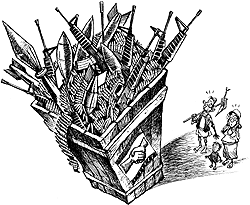 Subhas Rai has been drawing ever since he can remember. The draughtsman-ship itself seems to come easily to him, but like all professionals he grapples with the universal dilemma: does my work make any difference?
Subhas Rai has been drawing ever since he can remember. The draughtsman-ship itself seems to come easily to him, but like all professionals he grapples with the universal dilemma: does my work make any difference?
Journalists who work with words go through throes of such existentialist angst, too. After ten years of writing, they wonder whether what they have written has changed anything at all. Serious journalists seriously believe that the power of media is exaggerated, that it is given more due than it deserves as an agent of change. (Opportunist journalists need no convincing that the Fourth Estate is extremely powerful.)
So, it is natural for someone of Subhas Rai's calibre to wonder why. He needn't. A cartoon is worth a thousand words, and drives home the message using satire and humour much more effectively than mere words ever can. Change may not be immediate or dramatic, but thousands of pairs of eyes looking at a well-crafted cartoon will take in the message subliminally and the issue will become a matter of public debate.
Compared to journalists, cartoonists have it much easier. They are allowed to have a point of view, to be sharply critical. Reporters have to keep their biases to themsleves, and strive to be objective.
Also, in this visually-dominated media world, where newspapers are fighting a losing battle with television, infographics and cartoons take on added significance. They are not, should not be, just the one column filler on page one, they must expand to prominence, be directly interwoven with the page one text.
 Luckily, in Nepal the post-1990 growth in media has made editorial cartooning blossom into an important part of newspapers and magazines. Nepali cartoonists in fact have used new freedoms much more effectively than their text counterparts to push the envelope of what is allowed. They have tackled the traditional holy cows in Nepali politics to present biting satires of the traditional ruling elite in Kathmandu.
Luckily, in Nepal the post-1990 growth in media has made editorial cartooning blossom into an important part of newspapers and magazines. Nepali cartoonists in fact have used new freedoms much more effectively than their text counterparts to push the envelope of what is allowed. They have tackled the traditional holy cows in Nepali politics to present biting satires of the traditional ruling elite in Kathmandu.
Subhas Rai's cartoons and graphics have been the common feature of Himal Khabarpatrika and this newspaper for the past four years. By training himself in the latest computer graphics techniques, Rai's illustrations have a world class finish. But he has never abandoned the basic skills of an artist to the short-cuts and gimmicks of Quark Express. Rai\'s basic work is still done laboriously pen-in-hand on a piece of paper, and scanned for computer tinting.
Subhas Rai is one of Nepal's most versatile cartoonists. In the collection of his cartoons on peace (Peace Keeping) released this week, he drives home the message of non-violence and tolerance more than words could ever do.
Rai's distinctive and relaxed touch, and vivid imagery are familiar to readers of Nepali Times. But in this book, Rai expands his field of interest to include conflicts in Afghanistan, the Middle East, Iraq, India-Pakistan and Nepal. Every image forces us to reflect on the subject of peace and non-violence, and the humour gives us hope for the future.


